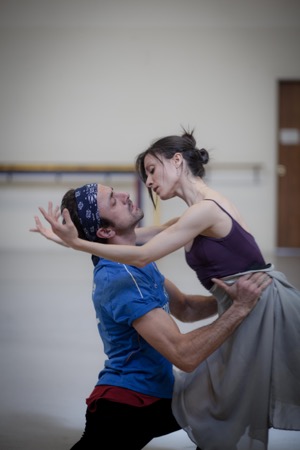
by Rachel Malehorn
Dancers who join classical ballet companies will be a part of the centuries-old tradition of the full-length ballet. These evening-long works not only showcase the brilliance of classical ballet technique, but also set this dancing in a dramatic context with the goal of telling a story. Even an audience member who has no background or understanding of dance can get lost in these stories, and can leave the theater transformed. Dancers spend years of their lives endeavoring to perfect their technique, but sometimes their power as actors and actresses can be overlooked or de-emphasized. The stories our ballets tell are magical, fantastic, romantic, tragic, and sometimes difficult. Throughout my career as a dancer, I have come to love and look forward to the dual opportunity to dance with accuracy—and also to convey the drama of these stories.
As Milwaukee Ballet prepares for its upcoming performances, I have been meditating on two important themes: the process wherein dancers and choreographers communicate the story of a full-length ballet, and the importance of telling these stories—even if they don’t always have happy endings. Romeo & Juliet, Manon, Onegin, Madame Butterfly, and even La Bayadere are classic tales of thwarted love, in which the tragic heroines suffer death or disaster as the price of their love.
But perhaps the epitome of the tragic ballet is Giselle, created in Paris at the peak of Romanticism. In this story, Giselle, a peasant girl, is wooed by Albrecht, an aristocrat in peasant disguise, but is driven to madness and death by the discovery that Albrecht is already engaged to be married to Bathilde, also an aristocrat. When Albrecht visits Giselle’s grave to beg for forgiveness, the Wilis – ghosts of other girls who have died of broken hearts – compel Albrecht to dance himself to death, but Giselle (seemingly inexplicably, and most definitely tragically) saves Albrecht from death and forgives him for his betrayal. At its core, Giselle is chilling, heartbreaking, and achingly beautiful.
Michael Pink’s Giselle
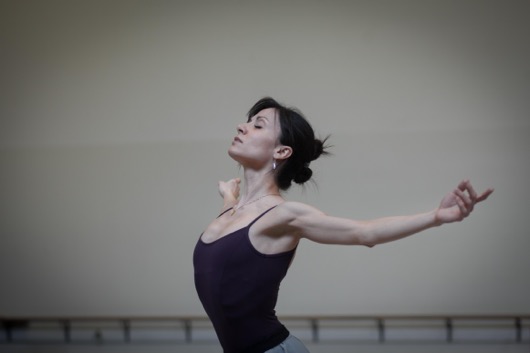
In Michael Pink’s adaptation of Giselle, the plot remains the same, but a crucial shift in setting adds yet another layer of depth. We find ourselves in Europe in the 1940’s, with World War II smoldering around us, and very quickly the themes of betrayal and forgiveness take on a different, darker significance. When I sat down with Mr. Pink, the artistic director of Milwaukee Ballet, to talk about the origin of his reimagining of Giselle, he pointed to the story’s inherent theatricality, as well as the universality of its themes of love, betrayal and forgiveness underscored by the ominous divisions of a classist society. Pink, along with director Christopher Gable and designer Lez Brotherson, endeavored to maintain the divide between the real, intellectual world of Act I and the mystical, visceral world of Act II as they nailed down the details of the adaptation.
The historical context of Europe in the ‘40s allowed for a minimalist, avant garde set (as opposed to the lavish, ornate sets of the original classic) which was a welcome contributor to Pink’s desire to allow the emotional nature of the story to float to the surface. A visit to the Jewish Federation in Leeds helped Pink research the subject matter so he could maintain accuracy in the details of the production. Pink also says that he didn’t shirk at an adaptation that reminds people of this ultimately tragic time in history. For some, the subject is an artistic taboo and too controversial to take on. However, Pink believes that the Holocaust is worth mentioning – an occurrence whose tragedy is worth reflecting upon.
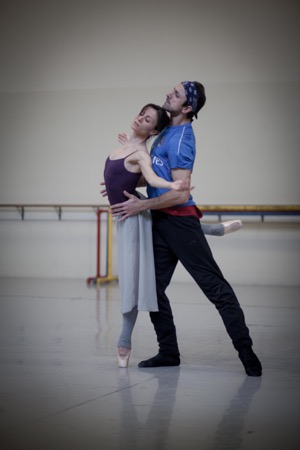
Freedom Of Choice And Storytelling
The heart of Giselle, as in all of Pink’s ballets, is the honesty of its storytelling. He requires his dancers to not only demonstrate technical proficiency with their dancing, but to also truly imagine themselves inhabiting the lives of the characters. To achieve this, Pink says, “I try to understand and respect the artist’s own personal choices – to let them have the freedom of choice.” This creates a sense of trust that Pink knows is crucial for his dancers. “I encourage the artist to get in touch with his or her own emotional reality, because it is from there that real, interesting, provocative acting choices can be made. Getting in touch with yourself emotionally is the best way to create your own [interpretation of a] character.”
Storytelling of this nature requires “bravery,” both on the part of the dancers telling the narrative, and of the audiences watching the ballet unfold. The bravery to insert oneself is critical to the art of storytelling, and Pink says, “Theater at its best should always provoke and challenge. Plays can do [this] without an actor ever having to leave his seat because of the use of words,” but with dance, we create this same impact through movement and music. Often we are able to evoke even more heightened emotional experiences because we leave room for interpretation. In particular, his impressionistic Act II allows and invites the audience to participate in trying to derive meaning from a seemingly senseless situation. The choreography in this section brings together earthy and contemporary movement to portray the ghosts of the ghetto, and the pristine classical choreography of the traditional Giselle for Albrecht and Giselle.
As in the original story, the theme of forgiveness takes center stage. Albrecht is asking for forgiveness not only as a man who has wronged a woman, but also because he is a man who is too weak to resist the crushing forces of society and of class, and in this case, of war. This rendition is tender, powerful, and thought provoking. That the two can find love in the middle of the war – although they are from two different worlds – is incredible. That he betrays her because he can’t (or won’t) escape his place in society is the true tragedy.
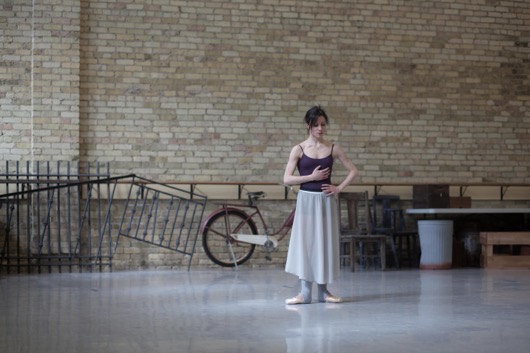
Creating Giselle
What does it feel like to play a character whose story is so intense? I asked Luz San Miguel, a leading artist with Milwaukee Ballet, to tell me about her experience with the dramatic aspects of classical ballet. Acting came naturally for San Miguel; she says, “I was always drawn to be an artist – I was such a dramatic little kid! Even when I was young, I used to make up characters and pretend to be somebody else.”
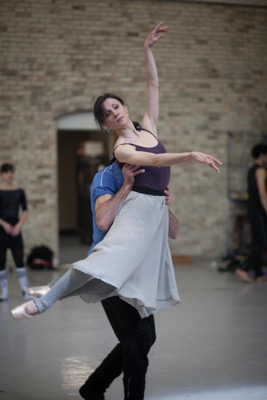
Her first opportunity to play a major character in a ballet was the role of Clara when she was 20-years-old. The director of her company in Germany wasn’t interested in coaching his dancers on their acting – he either liked it or he would move on to the next person. “They didn’t help me as much as Michael [Pink] tries to help people here,” she notes. San Miguel says she prefers to play characters whose stories encompass a broad range of emotions because, “you can go so deep and experiment with the character and, you know, happy is good but it’s a little shallow (for me). I love the arc of happy, sad, crazy, in love, heartbroken, desperate, everything.”
For her, the story leads her through the transition between emotions, and she is constantly thinking about how she can further develop her character. She also tries to come each day fresh into rehearsals: “I try to erase everything [from the day before], like that didn’t happen, because I don’t want to become fake and have something already set because I did that yesterday, and so I try to erase, and try to put myself in the emotional state of my character from the very beginning again, ” she says.
Sometimes, San Miguel says that when executing a particularly challenging variation or pas de deux, the technical aspects of the dance can make staying true to her character a struggle. With a laugh, she says, “you’re trying to be this person, and it’s hard to imagine – why is this character doing this crazy technical thing that makes no sense in the story?” To alleviate this, she says that repetition is key. Going back to the roots of the technique of the steps and practicing them over and over again allows her to spend more concentration on the storytelling of the moment. Also, “a lot of times it helps [me] even when [I’m] doing the technical stuff, to put [myself] in this emotional state. Just doing a developpe a la seconde, it’s like I’m begging for forgiveness, o please! So if I get into that emotion, it makes more sense for me and maybe (in that way) it’s easier.”
In terms of dancing the role of Giselle in Pink’s version, San Miguel says the most difficult aspect for her is to portray the joy and innocent love of a young girl, even though that young girl is in the midst of a horrible situation. “To get into Giselle, I did the research, and for me it’s just emotionally heartbreaking…And then forgiveness, finding forgiveness. I’m a very forgiving person, but there are certain things that (make me say) ‘wow, how am I going to forgive this guy?’”

Knowledge And Self-Discovery
San Miguel’s best advice on how to get into character for a role is to get as much knowledge about the character and the time period in which that character existed, because that knowledge will inform your acting decisions. “And then when I’m rehearsing, I always have a dialogue in my head. I am always saying something in my mind, like having a script as an actor.”
Even though roles like Giselle can be emotionally trying, San Miguel says that one of the most rewarding benefits of the experience is that with each new character she plays, she discovers new aspects of herself that she didn’t know were there. “Sometimes after shows [like this one] I will take twenty minutes alone in the dressing room to decompress. I don’t really get out of [character] until we are done [with all the shows.] That is the time when you can really put it aside. And then some roles…they stay with you. You will always take them with you, ” she says.

Engagement, Response And Transformation
In my time as an Artist with the Milwaukee Ballet, I have been a part of many different choreographic works. I have danced roles that are comedic and joyful, I have been the villain, I have danced in abstract pieces that have no identifiable narrative, and I have also taken on roles that require me to reach deep within the darkest corners of my heart. To portray a character that is in pain necessitates that I recall a time when I myself was in pain. This takes strength, but it also takes a transparency that can be extremely unnerving.
When asked about the necessity of tragedy in art, Michael Pink notices that within these stories we discover that “suddenly we have our minds opened,” and we therefore ask questions. From that place of vulnerability, we are shocked, scared, saddened, and we wonder why. Most importantly, we are obliged to respond to that piece of art. Whether it is in a negative or positive way doesn’t seem to matter. The point is that there is a response.
Oftentimes, we set ourselves up to simply be entertained, to consume, rather than become engaged. But there will always be a piece of art, or a play, or a movie, or a ballet, which catches us off guard and elicits an (unexpected) emotional response. These are the moments that Pink, and other choreographers like him, seek out – the times when we are left “engaged and almost breathless” because of what we have encountered. We talk to our friends, we ask them questions, and we ask ourselves questions that are often without easy answers. And it is through this process that we begin to know ourselves better – that we begin to understand a little bit more about the world around us – that we begin to truly develop a sense of human empathy that is so important to our world.
This is a memorable experience meant to do more than just entertain us. It transforms us. As artists who participate in the creation of work of this nature, we have the choice to scrape the surface, or to be brave and dig in deep.
See Michael Pink’s Giselle, performed by Milwaukee Ballet March 26th – March 29th.
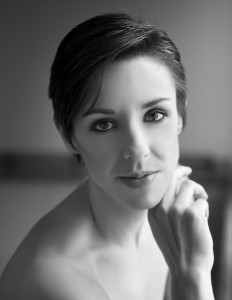 Originally from Pittsburgh, Pennsylvania, Contributor Rachel Malehorn received her formal training at the Pittsburgh Ballet Theatre School and continued on to graduate from the prestigious Nancy Einhorn Milwaukee Ballet II Program.
Originally from Pittsburgh, Pennsylvania, Contributor Rachel Malehorn received her formal training at the Pittsburgh Ballet Theatre School and continued on to graduate from the prestigious Nancy Einhorn Milwaukee Ballet II Program.
Since joining the Milwaukee Ballet, Malehorn has enjoyed performing works created by Val Caniparoli, Petr Zahradnícek, Mark Godden, Darrell Grand Moultrie, Jerry Opdenaker, Matthew Neenan and Alejandro Cerrudo. She has also performed as a semi-finalist in Palm Desert for the Dancing Beneath the Stars Competition, participated in the Northwest Professional Dance Project and danced with Texture Contemporary Ballet.
This is Malehorn’s eighth season with the Milwaukee Ballet.




